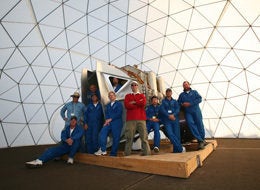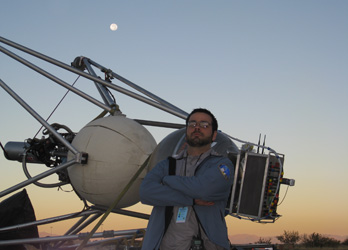
People often use the phrase "riding on someone's coat-tails" in a negative sense. Our society tends to look down on those who simply tag along with another's success, whether they be celebrity hangers-on or anything else. So, perhaps it's a bit strange that I take a great deal of pride in doing a job I basically consider to be Advanced Coat-Tail Riding.
For the last two and half years, I've worked at the X PRIZE Foundation, a not-for-profit educational foundation that incentivizes important technological breakthroughs by offering large cash prizes. In that time, I've had the enormous privilege of serving as a primary author and manager of both the Northrop Grumman Lunar Lander Challenge, a NASA-funded $2 million dollar prize for reusable rockets, and the recently-announced $30 million Google Lunar X PRIZE. The job has a great "cool" factor that we all enjoy, and the Foundation has an awesome staff--but the real pleasure and inspiration comes from interacting with the teams that compete for these prizes.

To do my job, I have to be sufficiently smart and diligent to identify a pressing problem that can be solved with the right amount of human ingenuity and attention. But--thankfully!--I don't have to be smart enough to solve those problems. Instead, I get a front row seat to watch as not just one but many incredibly creative, hard-working, and passionate geniuses pour their hearts into solving the problem I've helped identify. As such, I guess I'm not so much coat-tail riding as I am coat-tail steering.
I vividly remember the first time I got to meet Burt Rutan, the legendary aerospace pioneer who designed SpaceShipOne, the craft that won the original $10 million Ansari X PRIZE for suborbital spaceflight. I'd known about Burt for a while, and had followed his career closely for some time, but the first time I really got to spend time with him was one year after he claimed the Ansari X PRIZE, when he came to Washington, DC, to donate SpaceShipOne to the Smithsonian. The ceremony consisted of a press conference and a short public program, highlighted by brief talks from the director of the museum, Microsoft co-founder Paul Allen (who funded the development of SpaceShipOne, and donated the vehicle to the museum), and Burt. After the ceremony, most of the VIPs left--but Burt stayed on the floor of the museum for an additional two hours, talking to the tourists and fans who had come to see the ceremony.
Standing with the man who has not one but two vehicles hanging in the incredibly prestigious Milestones of Flight foyer (SpaceShipOne and Voyager, the first round-the-world aircraft), it was clear that we were connecting with a man of true genius and vision. But even more apparent was that we were talking to a man of incredible passion, an inventor who clearly loved his creations as though they were his children. That sort of passion is infectious, and addictive.
I've had the same sort of experiences interacting with the teams that are competing for the Northrop Grumman Lunar Lander Challenge. Though the prize purse is smaller, their passion and creativity is astounding. Similarly, the amount of camaraderie continually amazes me. These teams are in direct competition for $2 million in prizes, so one could reasonably expect them to avoid each other, or to show each other ill will. Instead, the teams actively support one another, share helpful tips, wish each other well, and even share parts with each other. Though they all want to win, they want even more to just see the damn thing done!
This past weekend, Armadillo Aerospace made a run for $1.35 million of the $2 million available in the Northrop Grumman Lunar Lander Challenge. A rag-tag team of volunteers who have never worked for a major aerospace company, team Armadillo has put together an insanely impressive track-record of designing, building, and flying rockets in almost no time and for budgets that wouldn't pay for the coffee at most standard aerospace businesses. And they've done this working without pay, only two days a week.
Ultimately, Team Armadillo fell short. A string of bad luck and about seven seconds of flight stood between them and a big check. The team was obviously disappointed, as was the audience. But what I'll take out of the weekend is something more positive. I observed elements that gave me hope: I saw the team display incredible creative ingenuity, constantly working to find innovative solutions, and using tools as simple as a filed-down paper clip to repair and replace rocket engines (something that usually takes months) in a matter of hours. I saw them remain in high spirits even after they knew they wouldn't win the money this year, still smiling because they had put on a good show, learned something about their systems, and walked away without hurting anyone or anything. I heard the voices of the leaders of Armadillo's competitors shaking and halting as they tried to contain their sympathy for Armadillo, viewed by all as a worthy competitor. But most of all it was the fire in each team's eyes as they realized that not all was lost, and that the prize money had all remained on the table for teams to claim next year.
With the prize money still unclaimed, I have not yet been able to ride any coattails into the annals of aerospace history. But the beauty of it all lies in the certainly I feel that some day, on somebody's coattails, we'll all get there.